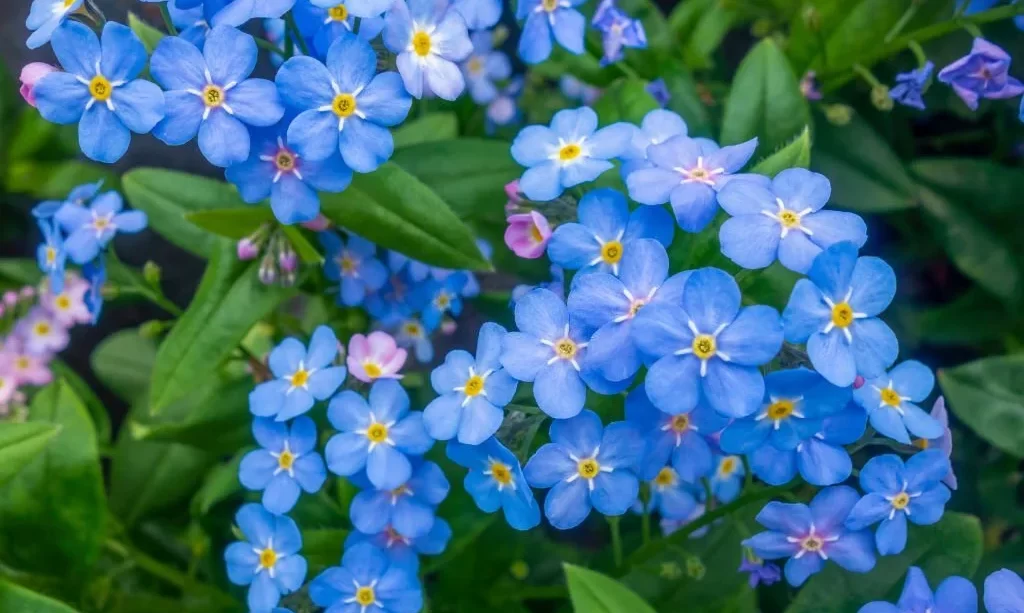Forget-Me-Nots, those delicate and enchanting blue blossoms, have a special place in the hearts of gardeners and nature enthusiasts alike. These tiny, sky-blue flowers are known for their timeless beauty and the touching sentiment behind their name. However, while their charm is undeniable, questions may arise about whether Forget-Me-Nots harbor any hidden dangers, especially in terms of toxicity. In this article, we embark on a journey to uncover the truth about Forget-Me-Nots and whether these beloved blooms carry any potential risks to humans and pets. Understanding the nature of these flowers is essential for responsible gardening and ensuring the safety of our natural surroundings.
- Flowers – Forget Me Not flowers form in clusters. They are tiny star shaped blooms in shades of pink, blue and white. The blooms last through the Summer months.
- Growth – This blend of Forget Me Not flowers will grow to a mature height of roughly 16 to 18 inches tall. Since these are technically biennials, they will flower profusely the second season and wilt later.
- Butterfly Garden – The colorful flowers that this mixture bring to the yard will attract pollinators, such as butterflies, bumblebees, honeybees, ladybugs and more.
- Quality – All seeds packaged by Seed Needs are intended for the current and the following growing seasons. All seeds are stored in a temperature controlled facility that is free of significant amounts of moisture.
- Quantity – Seed Needs offers generous quantities. You can share with friends and family, or you can save the extra seeds until the following season, if properly stored.
What Are Forget-Me-Nots?
Forget-Me-Nots, scientifically known as Myosotis, are a genus of enchanting flowering plants that belong to the Boraginaceae family. These dainty blossoms are celebrated for their petite size and their exquisite sky-blue petals with a distinct yellow center. Forget-Me-Nots are characterized by their five-petaled, flat flowers that are reminiscent of a gentle azure hue. These flowers have a long history in folklore and symbolism, often associated with true love and remembrance.
Forget-Me-Nots are perennial plants that typically grow in cool, temperate regions and are known for their ability to thrive in moist, shaded areas. Their name, “Forget-Me-Not,” is linked to a heartwarming legend in which a knight, while picking these blossoms for his beloved, slipped into a river and cried out, “Forget me not!” as he handed her the flowers. This touching tale has since given the flowers their evocative name.
Now, let’s delve deeper into the potential dangers, if any, that these captivating flowers may pose to humans and pets.
Potential Dangers of Forget-Me-Nots
While Forget-Me-Nots are beloved for their delicate beauty and sentimental symbolism, they are generally considered non-toxic to humans. However, it’s essential to note that there are rare cases of individuals who may be sensitive or allergic to certain plants, including Forget-Me-Nots. Skin irritation or mild allergic reactions can occur if a person with heightened sensitivity comes into contact with these flowers.
For pets, particularly cats and dogs, Forget-Me-Nots are also considered to have a low level of toxicity. The potential dangers primarily arise if a pet ingests a significant quantity of the plant material. Forget-Me-Nots contain small amounts of pyrrolizidine alkaloids, which can be harmful if consumed in large amounts. While cases of severe poisoning from Forget-Me-Nots are rare, it’s essential for pet owners to be aware of the potential risks.
Common Symptoms of Forget-Me-Not Poisoning
In the rare instances when a person or pet experiences adverse reactions to Forget-Me-Nots, the symptoms are generally mild and may include:
- Skin Irritation: Contact with the plant’s leaves or stems can result in skin irritation, redness, or itching, particularly in individuals with sensitive skin.
- Allergic Reactions: Some individuals may experience allergic reactions, such as red, itchy eyes or a runny nose, after handling Forget-Me-Nots.
- Gastrointestinal Upset (Pets): In pets that have ingested a significant amount of Forget-Me-Not plant material, symptoms may include vomiting, diarrhea, or drooling.
It’s important to emphasize that severe poisoning from Forget-Me-Nots is exceedingly rare in both humans and pets. However, if you suspect that you or your pet has ingested a substantial quantity of these flowers and experience severe symptoms, seek immediate medical attention for humans or veterinary care for pets.
In most cases, the risk associated with Forget-Me-Nots is minimal, and they can be appreciated for their beauty and symbolism without undue concern. Nevertheless, responsible gardening practices and awareness of potential sensitivities or allergies are always advisable when it comes to interacting with any plant.
Preventing Forget-Me-Not Poisoning
Preventing Forget-Me-Not poisoning in humans and pets involves responsible practices and awareness. Here are some practical tips to minimize any potential risks:
- Awareness: Be aware of your own sensitivities or allergies to plants. If you have a history of skin irritation or allergies to certain plants, take precautions when handling Forget-Me-Nots.
- Gardening Gloves: When gardening or handling plants, including Forget-Me-Nots, wearing gardening gloves can provide a protective barrier against potential skin irritation.
- Pet Supervision: If you have pets and are growing Forget-Me-Nots in your garden, supervise your pets while they are in the garden to prevent them from nibbling on plants.
- Pet-Friendly Gardens: Consider creating a pet-friendly garden with plants that are known to be safe for cats and dogs, minimizing the chances of accidental ingestion.
By practicing these preventive measures, you can enjoy the beauty and sentiment of Forget-Me-Nots without undue concern for potential risks.
What to Do If Exposed
If you or your pet are exposed to Forget-Me-Nots and experience adverse reactions, here are steps to take:
- Skin Irritation (Humans): Wash the affected area with mild soap and water to remove any plant residue. Apply a soothing lotion or anti-itch cream if necessary. Consult a healthcare professional if irritation persists or worsens.
- Allergic Reactions (Humans): If you experience severe allergic reactions, such as difficulty breathing or swelling, seek immediate medical attention.
- Gastrointestinal Symptoms (Pets): If your pet exhibits symptoms like vomiting, diarrhea, or drooling after ingesting Forget-Me-Nots, contact your veterinarian promptly.
Conclusion
Forget-Me-Nots, with their delicate beauty and heartwarming symbolism, are generally safe for both humans and pets. The potential dangers associated with these charming blue flowers are minimal and primarily affect individuals with specific sensitivities or allergies. Responsible gardening practices and awareness of potential risks are advisable when working with any plants, including Forget-Me-Nots.
As you tend to your garden or enjoy the presence of Forget-Me-Nots in nature, take comfort in the rarity of adverse reactions to these enchanting flowers. Remember, they are more likely to be a source of joy and remembrance than a cause for concern.




